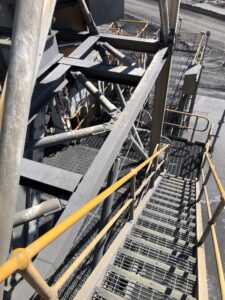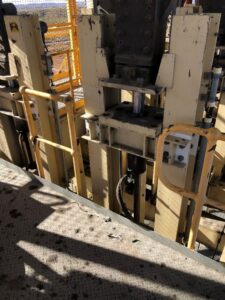In the mining and resources sector, mechanical engineers often associate AS/NZS 4024 with guarding requirements, while electrical engineers recognise it for its functional safety provisions. This standard is critical for ensuring the safety of machinery, and in 2024, several key updates were introduced. These changes have practical implications for engineers working with plant design, maintenance, and risk management.
As General Manager of Engineering at Waterline, my team has deep knowledge of these standards and collaborate with clients to keep their sites operating efficiently and safely. Understanding these updates is essential for maintaining compliance, improving safety, and implementing best practices in machinery access, guarding, and control systems.
Machine walkways and platforms
Traditionally, AS1657 has been applied to Access Platforms and Walkways in all contexts, even around machines. The 2024 updates to AS/NZS 4024 introduce AS/NZS 4024.2201, AS/NZS 4024.2202, AS/NZS 4024.2203 and AS/NZS 4024.2204 that cover access to machines, including working platforms, walkways, stairs and ladders. These standards are adopted from the ISO standards, and apply where access is required to a stationary machine. There have been some adaptations to the original ISO standards to align with the higher standards of safety in AS 1657 compared to the original ISO standards.
Where we traditionally may have used AS 1657 to design platforms and ladders for maintenance or operator access to machines, we should now refer to the AS 4024 series. Under the new standard, differences include a reduction in minimum clear walkway width to 500 mm for short walkways under 2000 mm. AS/NZS 4024.2202 also provides guidance around gaps between platforms and adjacent equipment and what guarding and toe-plates are required depending on the gap. This is relevant where platforms are immediately next to tanks, mills, cyclones and other equipment, or where penetrations exist for pipes, hoist ropes or other elements.
 |
 |
| Walkway providing general access—AS 1657 applies | Walkway providing access to a machine—AS 4024.2201-2204 applies |
Guarding
AS 4024.1601 covers guarding, and was updated in September 2024. The new revision of the standard provides some additional examples and clarity around methods of verifying guarding designs. The updated standard retains all of the same safety distance requirements, requirements around fasteners and other key design considerations.
Future updates
For the Electrical Engineers, the Australian Standards committee are working on updates to AS4024.1503 which covers the safety related parts of control systems. The adoption of IEC 62061:2024 is in progress and there are also some changes to European Standards around control system cyber security that may be adopted in future updates.
Considerations and future implications
For existing plants, the new standards provide a guide for identifying safety improvement opportunities. The standard should be used to identify risk exposure, with risk management processes applied to ensure risk exposure is acceptable. Engineers who are working on designs for plant upgrades, new access platforms, and walkways around machines should be aware of when to apply AS 1657, and when the AS/NZS 4024.2201-2204 standards should be applied.
Next steps and expert guidance
Need guidance on how these updates affect your site? Contact our expert team:
Their expertise can help ensure your plant and equipment align with the latest safety standards. Get in touch with our team today and we will collaborate with you to ensure your personnel and sites are safe.
Key takeaways
- New walkway and platform standards provide clearer guidance for machine access
- Guarding verification improvements enhance clarity in design validation
- Upcoming functional safety updates will impact electrical control system design
- Engineers should integrate these updates into new plant designs and risk assessments
By staying ahead of these changes, engineers can enhance safety, compliance, and operational efficiency in mining and resources projects. Download a PDF version of this white paper here.


